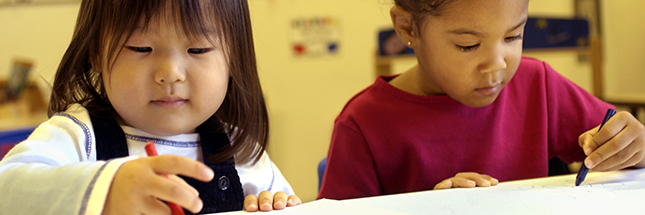Standardized Testing for Pre-Schools

Standardized testing for preschool-aged children is a highly-debated issue in the United States education system. Many parents, teachers and institutions do not believe that the intelligence, competence, and achievements of a four-year-old can be measured in a standardized testing setting. Others simply refuse to let a singular test score define their early learners. One journalist called the practice of administering standardized tests to kids’ “madness.” But in spite of all those who are opposed to it, standardized testing is often used to determine whether a child is ready to enter kindergarten. In fact, 22 states require student assessment and a total of 25 states have a pre-approved list of assessments for schools that would like to conduct testing.
Difficulties
There are clear difficulties associated with standardized testing for very young children between the ages of three and five. Many young students do not have the mental capacity to understand the concept of or significance of testing and apply themselves accordingly. For instance, a four-year-old might answer that he or she does not feel like answering an adjudicator’s questions or he or she may deflect attention to other things. This can result in a score that doesn’t necessarily reflect the child’s aptitude or ability. The challenge is in finding ways to develop and administer standardized tests that account for these issues.

Misconceptions
There are some common misconceptions related to standardized testing for youngsters. For one, most standardized tests aren’t pencil and paper tests as is the case for most older students. A literacy test, for instance, might involve the student sitting down with a teacher or adjudicator and answering questions about letters, pictures, and sounds. Other tests are purely observation-based; students play as they normally would while a test adjudicator observes and takes notes. A number of kindergarten readiness tests cover a wide variety of domains in order to ensure that children who aren’t as strong in main areas such as math and literacy don’t get held back.
Advantages
Standardized tests do have some advantages. Reliable standardized tests help to compare students to childhood development norms or other students in similar situations. In many cases, standardized tests can help to predict whether a student will perform well in upcoming years. Research has shown that students who perform well on standardized tests in preschool also perform well on tests in kindergarten and primary schools. In many cases, standardized tests need not be used to determine whether a child should be held back from or promoted to kindergarten. Instead, they may serve as a guideline to help teachers describe student development and next steps to parents. They may also help teachers to identify areas where their own curriculum, resources, or instruction style is lacking.
Common Standardized Tests and Inventories
Some of the most commonly-used tests for preschoolers include the Battelle Developmental Inventory, which takes one to two hours and is designed for children up to the age of eight. The complete inventory includes five domains: personal-social, adaptive, motor, communication, and cognitive. It can also be used to test children with developmental disabilities or handicaps. Another popular standardized test is the Developmental Indicators for the Assessment of Learning (DIAL). It is used for assessing large groups of children quickly. It also assesses five domains: social development, self-help, language, concepts, and motor. It takes up to a half an hour to administer.
